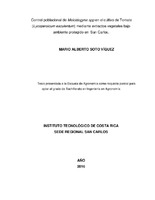Mostrar el registro sencillo del ítem
Control poblacional de Meloidogyne spp en el cultivo de Tomate (Lycopersicum esculentum) mediante extractos vegetales bajo ambiente protegido en San Carlos
| dc.contributor.author | Soto-Víquez, Mario Alberto | |
| dc.date.accessioned | 2018-08-03T13:59:10Z | |
| dc.date.available | 2018-08-03T13:59:10Z | |
| dc.date.issued | 2016 | |
| dc.identifier.uri | https://hdl.handle.net/2238/9847 | |
| dc.description | Tesis (Bachillerato en Ingeniería en Agronomía). Instituto Tecnológico de Costa Rica, Escuela de Agronomía, 2016. | es |
| dc.description.abstract | The effect of different plant extracts on the population of Meloidogyne ssp. was evaluated in tomato hybrid cultivar "JR" inoculated with 100 and 150 individuals of eggs and young nematodes per container 10 L under protected environment. Treatments were distributed into three groups ("Absolute Control" in water with and without inoculated population; "Plant extracts" (50 and 100 ppm), based on Chili (Capsicum chinensis), Queen of the Night (Brugmansia suaveolens), and Tagetes (Tagetes erecta); lastly, "Chemical Control" (Oxamyl, 50 and 100 ppm). The evaluations were performed at 30, 60 and 90 Days of Exposure to the Extract (DEE). For 30 DEE, Chili (50 ppm) obtained the best result for "Eggs in Root" with an average of 2.622,75, and water got the best in "Nematodes in Root" (average of 250 individuals). Regarding 60 DEE, for the variable "Eggs in Root", the best results were obtained by Tagetes (50 and 100 ppm) (averages 2.887,50 and 2.912,50, respectively), and Oxamil (100 ppm) (average 2,475). For the variable "Nematodea in Root", the best results were Queen of the Night (50 ppm), Tagetes (100 ppm) and Oxamil (50 and 100 ppm) with averages of 625, 833, 33, 162, 50 and 321, 50 nematodes, respectively. Within 90 days of exposure to the extract "Eggs in Root", the best result was obtained by Tagetes (100 ppm) with 200 and Oxamil (50 ppm) with 250. xi Concerning the correlation coefficients in the population dynamics of Meloidogyne spp., the most important variable weigh in plant is "Fresh Root Weight" in 30 DEE. The best results were the treatment Queen of the Night (50 ppm), which negatively correlated with the variable "Nematodes in Root" (r = -1,00), stating that the greater the number of "Fresh Root Weight", the fewer nematodes present in the root. For the treatment Tagetes (100 ppm), "Fresh Weight in Root" negatively correlated with "Nematodes in Soil" (r = -0,80) and "Nematodes in Root" (r = -0,80). Concerning the treatment Oxamil (50 ppm), the variable "Fresh Weight in Root" negatively correlated with "Nematodes in Root" (r = -1,00). In the in vitro study of individual mortality Meloidogyne spp. was assessed on three consecutive days of exposure to the extracts. On the first day, Oxamil (50 and 100 ppm) showed higher percentages of mortality (83,3% and 100%, respectively). The second day Tagetes (50 ppm) obtained 86,7% mortality, while Oxamil (50 and 100 ppm) showed no changes from the first day. The third day, the percentage of mortality in Tagetes (50 ppm) increased to 90% and in Oxamil (50 ppm) to 100%. | es |
| dc.language.iso | spa | es |
| dc.publisher | Instituto Tecnológico de Costa Rica | es |
| dc.rights | acceso abierto | es |
| dc.subject | Cultivos agrícolas | es |
| dc.subject | In vitro | es |
| dc.subject | Extractos vegetales | es |
| dc.subject | Research Subject Categories::FORESTRY, AGRICULTURAL SCIENCES and LANDSCAPE PLANNING::Plant production | es |
| dc.title | Control poblacional de Meloidogyne spp en el cultivo de Tomate (Lycopersicum esculentum) mediante extractos vegetales bajo ambiente protegido en San Carlos | es |
| dc.type | proyecto fin de carrera | es |


